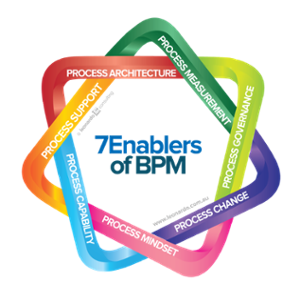7Enablers Deep Dives: Process Architecture and Process Measurement.
There are seven elements, the 7Enablers of BPM, that come together to create and sustain process-based management:
- Discovery, understanding, and documentation of the organization’s processes and related resources in a hierarchical model—process architecture
- Defining process performance measures and measurement methods, collecting and reporting process performance data—process measurement
- Reimagining, and responding to, process performance anomalies, innovation opportunities, and general process hygiene—process governance
- Continuously finding ways to close process performance gaps by eliminating problems and capitalizing on opportunities—process change
- Creating an environment where the organization, its people, and their teams are always conscious of the processes in which they participate—process mindset
- Developing the tools and skills required throughout the organization to identify, analyze, improve, and manage business processes—process capability
- Providing the support required throughout the organization to develop, sustain and realize the benefits of process-based management—process support
The first three enablers—architecture, measurement, governance—are tangible, whereas the final three—mindset, capabilities, support—are more abstract (but no less important). Change is in the middle and is the central objective of process management.
To thrive, perhaps even to survive, in times when ‘doing more with less’ seems both inevitable and impossible, executives need to step back from day-to-day functional issues and reimagine their organizations as value creation and delivery flows. Process-based management delivers a practical, proven approach and the 7Enablers of BPM represents a breakthrough in management practice.
These enablers are shown in the image above. A Mobius strip format is used to highlight the interdependencies between the elements. The enablers are interconnected—change one and one or two others are likely changed, change several and they will all be changed. The 7Enablers represent the key levers of process-based management.
The core enabler is the process architecture since documenting the key processes is the necessary first step. Once documented, processes can be measured and once measures are available, governance arrangements to define who should respond to performance reports and change opportunities are required. These first three enablers (architecture, measurement, governance) are the ‘physical infrastructure’ on which the rest is built. Continuous process change is the cornerstone of process-based management. Without process improvement, both small changes and large innovations, what is the purpose of process analysis and management? For process management and improvement to become ubiquitous, it must be embedded in the organization culture and mindset. Having a central specialistsupport group to do all process work, does not scale and will soon impose a bizarre restriction on process management and improvement work. Therefore, it is necessary to build the capability for identifying, analyzing, improving, and managing business processes throughout the organization.
The 7Enablers is a collective of mutually supportive prerequisites for successful and sustained process-based management.
Read more in Roger Tregear’s blog post introducing 7Enablers
Each of the 7 enablers will be described in further details. So far, two of the enablers have been described:
